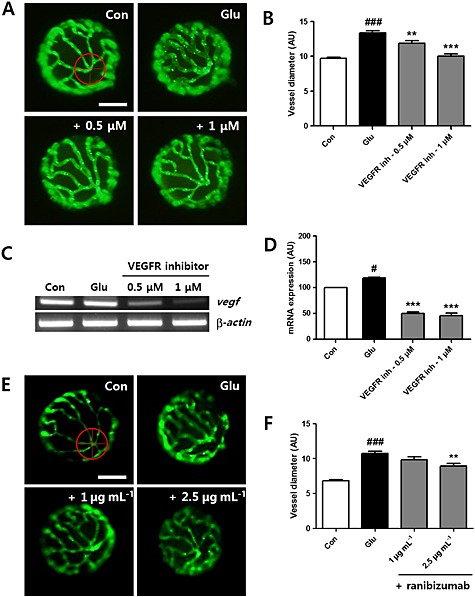Figure 6.

Vegf expression and the effect of the VEGFR inhibitor and the VEGF antibody ranibizumab in HG‐treated larvae. (A) The effect of the VEGFR inhibitor on dilated hyaloid‐retinal vessels. Vessel dilation induced by HG was blocked by treatment with the VEGFR tyrosin kinase inhibitor (0.5 or 1 μM). Scale bar = 40 µm. (B) The diameter of hyaloid‐retinal vessels in HG‐treated larvae with VEGFR inhibition was similar to control. Graph data are displayed as the mean AU for vessel diameter. ###P < 0.001 versus control; **P < 0.01, ***P < 0.001, significantly different from HG, n = 8–10 embryos per group. The vessel diameter of each lens was measured three times. [(C) and (D)] Expression of Vegf in HG‐treated larvae increased significantly compared with control and was reduced by treatment with the VEGFR inhibitor. No changes in the transcript levels of β‐actin were detected between control and HG‐treated larvae. #P < 0.05, significantly different from control; ***P < 0.001, significantly different from HG. (E) The effect of the VEGF antibody, ranibizumab, on dilated hyaloid‐retinal vessels. HG‐induced vessel dilation was morphologically rescued by ranibizumab treatment (2.5 µg·mL−1). Scale bar = 40 µm. (F) The diameter of hyaloid‐retinal vessels in HG‐treated larvae with ranibizumab treatment was significantly reduced. Graph data are displayed as the mean AU for vessel diameter. ###P < 0.001, significantly different from control; **P < 0.01, significantly different from HG, n = 8–10 embryos per group. The vessel diameter of each lens was measured three times.
